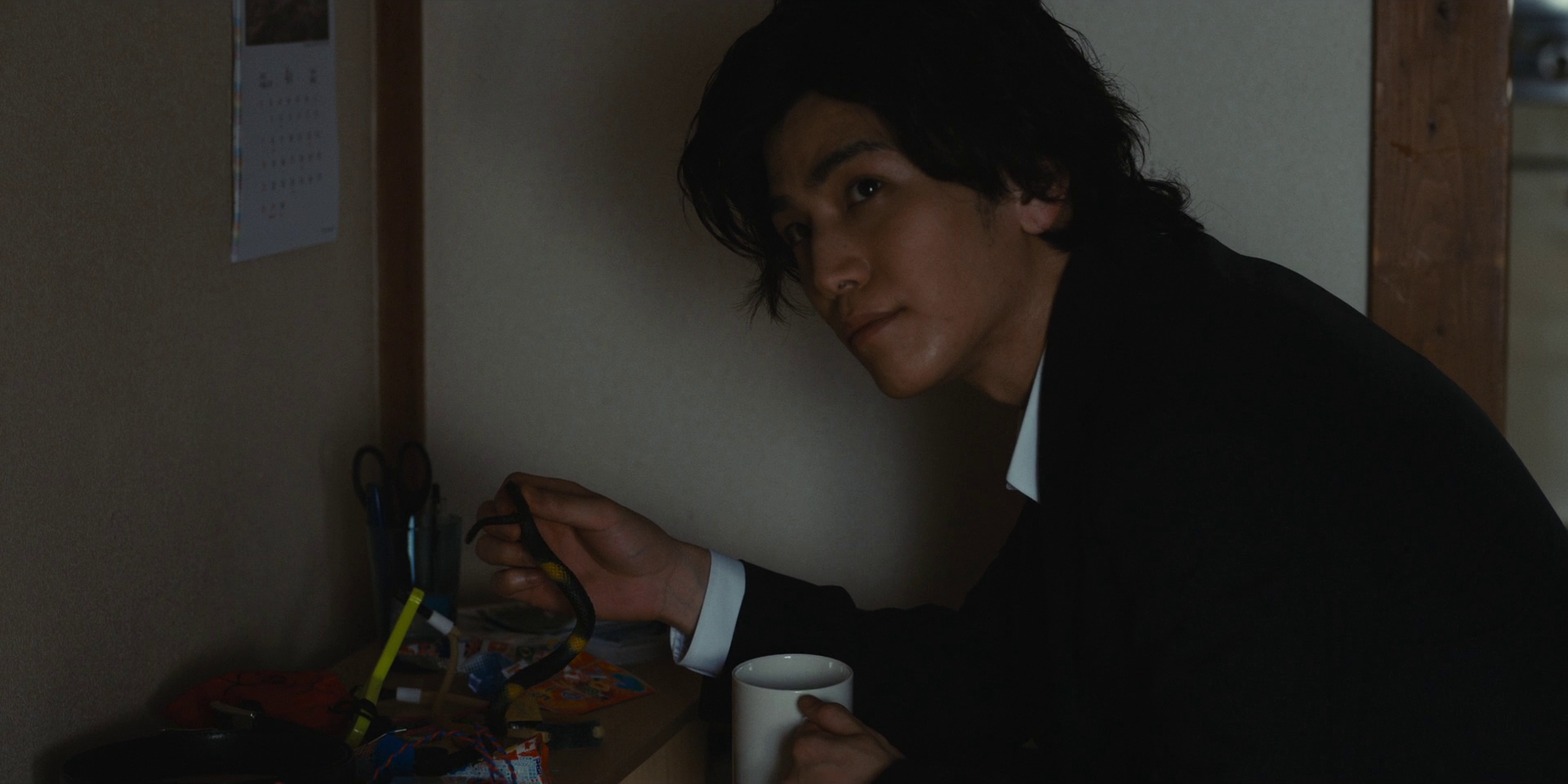Introduction
Yuichi Sato might not be the most successful or the most widely praised Japanese director, yet one cannot deny that is he has created some pleasant narratives like Kisaragi (2007), Poison Berry in My Brain (2015), and Kasane: Beauty and Fate (2018). Can he deliver a pleasant adaptation of Kaoru Yukinari’s best-selling novel Na mo Naki Sekai no End Roll (2013) or will he add a false note to his repertoire?
Review
From his childhood on, Kida (Takanori Iwata) has enjoyed being pranked by Makoto (Mackenyu Arata) and pranking Yocchi (Anna Yamada) with Makoto. The trio are, in fact, inseparable, but an incident causes Yocchi to radically disappear from their lives.
A few years later, a young woman called Lisa (Anne Nakamura) parks a damaged red-sports car in the garage, Auto Shop Jim, where Makoto and Kida are now working. Makoto takes an ‘romantic’ interest in her and immediately takes a chance on her by inviting her out to dinner, but she brushes him off. Kida, upon realizing Makoto’s romantic interest, indirectly tells him that he does not make a chance because they inhabit different worlds – ‘poor’ vs ‘rich’. Yet, Makoto does not heed Kida’s warning, quits his job, and disappears without a trace. Two years later, Kida joins the world of crime as negotiator to find his long-lost friend. Upon finding him, Makoto asks him to help him with ‘operation proposal’.
To allow the spectator to enjoy The Master Plan, we will refrain from delving to deep into the narrative. Yet, a few remarks about Yocchi, Makoto, and Kida are necessary to allow the spectator better appreciate Sato’s film. Yocchi is marked by a lingering fear to be erased as subject from the symbolic network, from the Other. This fear is not only the fear to have her right to symbolically exist revoked, but also to have to do without any kind of societal recognition, to not be recognized by the Other. It is not difficult for the spectator to realize that her desire to become an actress is function of this lingering subjective fear.
Makoto is still trying to become a man worthy of his beloved Lisa. Makoto’s comportment is, at first glance, solely determined by the imaginary. His romantic interest seems to be caused by the simple scopic encounter with her elegant presence/image – an encounter giving his desire a goal, and his subsequent acts to attain his goal are focused on donning himself with the image of a handsome rich man that would be worthy of her consideration. For the spectator, Makoto is merely chasing a phallic fantasy – ‘I hold the phallic shine you desire’ -that lies beyond any kind of intersubjectivity.
In Kida’s case, the spectator is left wondering what his motives or desires are. Why does he work as dark negotiator? Why does he help Makoto with chasing his fantasy? Yet, as the The Master Plan progresses, some of the signifiers he vocalizes – those in the past as well as in the present – vaguely imply that his current desire circles around the ‘absent’ Yocchi.
Due to these two ‘romantic’ desires, the spectator is led to wonder who the true target of ‘operation proposal’ is – Lisa or Yocchi? – and if the goal of this operation does not lie beyond any romantic endeavours. As the spectator starts doubting the true target of the operation, he also led to question who the true orchestrator of the master plan is, Makoto or Kida.
The structure of the narrative is pleasant and instrumental in keeping the spectator engaged. Not only does this structure whet the spectator’s appetites by revealing, in the beginning, that Kida and Makoto are undertaking ‘operation proposal’, but also by purposefully slowing down the unfolding of this ‘operation’ by offering a composition of flashbacks, flashbacks that explore the important moments of Kida, Makoto, and Yocchi’s friendship as well as flashbacks that reveal Kida’s trajectory – from finding his friend to ‘aiding’ him in pulling of his master plan off.
Due to the slow narrative build-up, The Master Plan creates the expectation in the spectator that a big pay-off will follow, that the actual master plan will indeed be masterfully and emotionally bombastic. Yet, this is where Sato’s narrative falters. While all the necessary elements are present, Sato is not able to combine them into a truly emotionally explosive finale and satisfying catharsis. Yet, this is not entirely Sato’s fault. The structure of the narrative does not only create (too) high expectations, but Takanori Iwata and Mackenyu Arata are unable to give the romantic dimension its genuine feel and the emotional power to breathe the necessary life into the finale.
Due to a lack of genuine emotionality the societal critique that lingers in The Master Plan fails to impress. Sato’s narrative does not only touch upon the way societal preconceptions poison the subject’s thinking and perception (e.g. see the high-class spoiled and conceited Lisa) and the suffocating pressure some subjects feel by being subjected to the expectations of the Societal Other (e.g. see hikikomori ‘perfectionist’ Makoto Onose), but also on the power that the elite wields to not only erase what is unsavory for their image and what might complicate their hold over power but also to maintain the very fiction of honesty and righteousness to the Other
.
The composition of The Master Plan offers a straightforward mix between dynamic and static (Cine-note 1). And while this is not bad per se, Sato misses various opportunities that would not only have heightened the visual pleasure of his composition, but also aid in keeping the spectator engaged. One strange thing in his composition concerns the few shots in the opening of the narrative that are framed with shaky framing. Why did Sato only use in a few shots, while it could have prepared the spectator for the sudden twists and allowed the tension to accede to a tangible level?
One pleasant visual touch is the manipulation of the colour-palette. The spectator will easily realize that the further the flashback is in the past, the warmer the colours are. These colour-shifts subtly emphasize Yocchi’s absence and signal that the amical relations between our three friends are not what they used to be (Colour-note 1).
The subtlety of the musical pieces has as benefit that the evoked atmosphere does not overpower the performances. In a certain way, the music is a frame upon which the subtle emotionality (sadness, playfulness, …etc.), a subtle lingering threat, or the tension within certain interactions can be more clearly brought to the fore. Yet Takanori Iwata and Mackenyu Arata are not able to utilize this music to strengthen their performances and breathe life into the emotions they try to convey. Anna Yamada’s performance is much better – the veritable highlight of the film, but this performance is not enough to make the romantic dimension potent and the finale truly satisfying.
The Master Plan might be pleasant, but ultimately fails to deliver the emotional catharsis it so clearly promises. Sato’s narrative is, in fact, a film that reveals one possible reason why certain novel-adaptations fail to live up to their potential. As the director cannot solely rely on the reader/spectator to infuse their emotions into the characters and their actions, he needs a kind of cast that can emulate the emotions of the book on the screen. Sadly, Sato male actors are not refined enough to evoke the complexity of the characters and deliver the spectator the emotional punch he is so ready to receive.
Notes
Cine-note 1: The shifts from present to the past are also introduced by intertitles. These intertitles allow the spectator to know to which year the narrative shifts.
Colour-note 1: For the finale, Sato manipulates the colour-palette to deceive the spectator about nature of the event.





